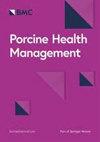屠宰前停放时间对猪应激的影响:路径分析
IF 3
2区 农林科学
Q1 VETERINARY SCIENCES
引用次数: 0
摘要
屠宰前的运输、装卸和饲养过程会对猪造成应激,影响动物福利和肉质。因此,屠宰场因素对缓解应激非常重要。本研究以 24 头 LYD(Landrace × Yorkshire × Duroc)种公猪为研究对象,探讨了 6 小时和 20 小时放牧时间(LT)对血液中皮质醇、血清素和儿茶酚胺以及肌肉中生理因子的影响,并验证了这些因子之间的因果关系。结果表明,与 6 小时相比,20 小时的皮质醇增加(0.064 ± 0.007 µg/ml),肾上腺素(0.020 ± 0.002 µg/ml)和去甲肾上腺素(1.518 ± 0.071 µg/ml)降低,但对肌肉和胴体特征因子无显著影响。此外,皮质醇和去甲肾上腺素呈负相关(r = -50,346,p = 0.0121),肾上腺素和糖原呈正相关(r = 0.4417,p = 0.0307),血清素和热休克蛋白 70(HSP70)呈正相关(r = 0.4715,p = 0.0200)。路径分析表明,LT 的增加对皮质醇、肾上腺素和去甲肾上腺素有直接影响,对肌糖原有间接影响。这项研究证实,在饲养室中饲养 6 至 20 小时,LT 的增加会对猪的应激反应产生影响。这些研究结果支持了主张缩短猪舍饲养时间的法律要求,以符合更高的动物福利标准。本文章由计算机程序翻译,如有差异,请以英文原文为准。
Effect of lairage time prior to slaughter on stress in pigs: a path analysis
Pre-slaughter process during transportation, handling, and lairage causes stress in pigs, affecting animal welfare and meat quality. Therefore, lairage factors are important for relieving stress. A total of 24 LYD (Landrace × Yorkshire × Duroc) barrows were used to investigate the effect of 6 and 20 h lairage time (LT) on cortisol, serotonin, and catecholamine in blood and physiological factors in muscle, and to verify the causal relationship between these factors. The results revealed that cortisol was increased (0.064 ± 0.007 µg/ml), and epinephrine (0.020 ± 0.002 µg/ml) and norepinephrine (1.518 ± 0.071 µg/ml) were lower at a LT of 20 h than those at 6 h, and there was no significant effect on the muscle and carcass characteristic factors. In addition, cortisol and norepinephrine showed a negative correlation (r = -50,346, p = 0.0121), epinephrine and glycogen had a positive correlation (r = 0.4417, p = 0.0307), and serotonin and heat shock protein 70 (HSP70) were positively correlated (r = 0.4715, p = 0.0200). Path analysis indicated that the increase in LT had a direct effect on cortisol, epinephrine, and norepinephrine, and an indirect effect on muscle glycogen. This study confirmed the effect of the increase in LT from 6 to 20 h in the lairage room on the stress response of pigs. These findings support the legal requirements that advocate for shorter lairage times, in alignment with enhanced animal welfare standards.
求助全文
通过发布文献求助,成功后即可免费获取论文全文。
去求助
来源期刊

Porcine Health Management
Veterinary-Food Animals
CiteScore
5.40
自引率
5.90%
发文量
49
审稿时长
14 weeks
期刊介绍:
Porcine Health Management (PHM) is an open access peer-reviewed journal that aims to publish relevant, novel and revised information regarding all aspects of swine health medicine and production.
 求助内容:
求助内容: 应助结果提醒方式:
应助结果提醒方式:


